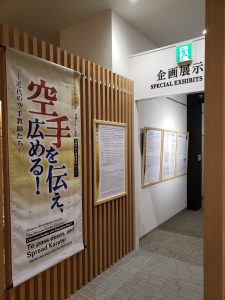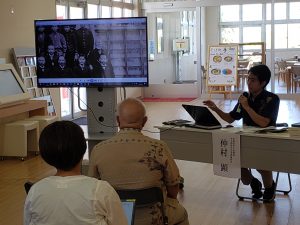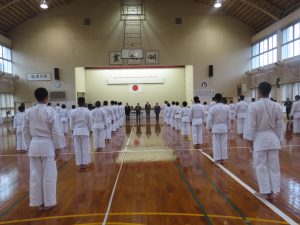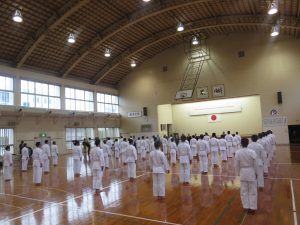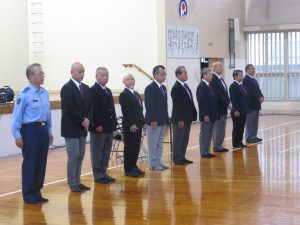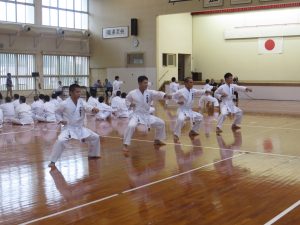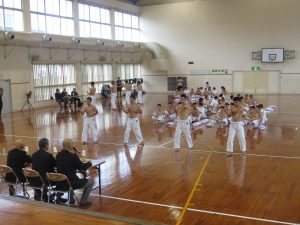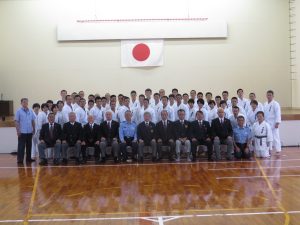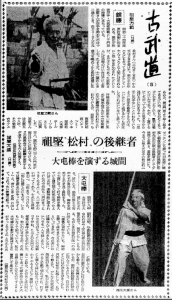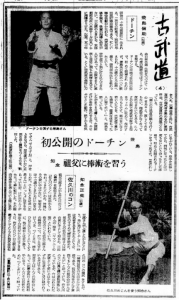Special feature articles
-
2023.09.19
Karate Today - Yoshizato Hiroshi's Birth!
-
2023.08.29
Karate Today - Honolulu Karate Youth Club Found...
-
2023.08.15
Karate Today - Nakandakari’s Birth!
-
2023.08.03
Karate Today - Noma Seiji made his wedding in O...
-
2023.07.18
Karate Today - Yabu Kentsu conducts Karate prom...
-
2023.07.04
Karate Today - First "Karate Club" created for ...
-
2023.06.20
Karate Today - Yoshimura Chogi visited the form...
-
2023.06.06
Karate Today - Karate club at Prefectural First...
-
2023.05.26
Karate Today series will begin
-
2021.12.20
Martial arts demonstration in front of the king...
-
2021.03.08
Folktale: Why tigers can't climb trees
-
2020.12.22
About Rei – Part 2 by Nakamoto Masahiro
-
2020.11.17
Okinawa Karate "WA" Series
-
2020.10.05
About Rei – Part 1: Mabuni Kenei
-
2020.06.19
1969 article on master Yagi and Sūpārinpe
-
2020.05.22
1969 article on master Higa and Passai Dai
-
2020.05.08
1969 article on master Shimabukuro and Ānankū
-
2020.04.20
1969 article on master Kushi and Wankan
-
2020.04.14
1969 article on masters Kaneshima and Nagamine
-
2020.04.09
Article ”Even at 80 years old “Eyaa!” ” (Okinaw...
-
2020.04.09
Article ”Impressed with every move” (Ryūkyū Shi...
-
2019.12.03
Kobudō 9: Nakaima Kenkō and Uchima Anyū
-
2019.11.07
Kobudō 8: Kyan Shinei and Kaneshima Shinei
-
2019.10.29
Kobudō 7: Ishikawa Hōei and Higa Seitoku
-
2019.10.08
Kobudō 6: Nohara Kamaichi and Takara Shigeru
-
2019.09.13
About the estimated new photo of Itosu Ankō
-
2019.09.02
Karate policemen protecting the safety and secu...
-
2019.07.02
Kobudō 5: Soken Hōhan and Shiroma Taisei
-
2019.06.08
Kobudō 4: Kameshima Shinsuke and Chinen Masami
-
2019.06.01
Kobudō 3: Nakamura Shigeru and Higa Yūsuke
-
2019.05.24
Kobudō 2: Irei Matsutarō and Nakamura Heisaburō
-
2019.05.14
Kobudō 1: Kina Shōsei and Shinjō Heisaburō
-
2019.04.08
Questioning the weapons’ hunt
-
2019.01.21
Kyō Ahagon Jikki, the sword and karate
-
2018.05.04
The unveiling of the statue of Uechi Kanbun
-
2017.12.26
Following the steps of Matsumora Kōsaku
-
2017.10.20
Brushwork of late Matsumura Sōkon
-
2017.10.14
Maekawa bō performed at the Shihan Gakkō
-
2017.09.08
The declaration of the "Karate Day"
-
2017.08.15
A district connected to karate, Uebaru
-
2017.07.14
The beauty of Okinawa karate
On September 12, the Okinawa Prefecture Karate promotion division unveiled a new special exhibition inside the Okinawa Karate Kaikan’s special exhibit room. It is titled “To pass down, and spread karate!”
On the commemoration of the opening, a lecture titled “A new hypothesis on the Itosu Ankō photo” was given by part-time staff and karate researcher at the Karate promotion division, Nakamura Akira. We are hereby introducing the content of the lecture based on documents produced during the lecture.
After an announcement at the Okinawa Karate Academy held in March this year (See: Itosu Ankō – Re-examination of the photo), Mr. Nakamura continued to collect and verify photographic materials. End of March, he noticed that there were many Okinawa-related historical materials in the Nakajō Bunko collection preserved in Kochi City’s Library (also known as Otepia Kochi Library).
The Nakajō Bunko is a collection made of old documents property of the Nakajō Family, an old family of Kochi Prefecture. Nakajō Naomasa (1868-1925) was a teacher at the Okinawa Prefecture Middle School. According to Mr. Nakamura’s research, he might be the first non-Okinawa to have learn karate (1).
As the investigation went on, it came out that there were 45 Okinawa related photographs in the collection. Among them, five school-related photographs titled “Okinawa Prefectural Middle School Teachers and Students” were found.
From there, Mr. Nakamura conducted a detailed investigation based on the persons present in the pictures and revealed the year each photograph was taken.
The result of his studies shows that the five photos are from the 15th up to the 19th graduation ceremonies of the school from March 1903 to March 1907. It appears that the presence of Henry Amoore (2), a professor of English for three years from 1905, was the hint that allowed the establishing of the chronology of the photographs.
According to the history of Okinawa Prefectural Middle School, karate instruction with Itosu as karate professor started from January 1905. There is thus a possibility that he appears in a graduation photo after the 17th graduation ceremony of March 1905. Therefore, 3 of the 5 found photos found are subject photos. In two of them, a person who could be estimated as being Itosu is nowhere to be found.
Born in 1831, Itosu Ankō was 74 years old in 1905, and there is only one person who can be viewed as a person of such age. Looking at the 17th graduation photo dated of 1905, Nakamura determined that the person standing at the right end of the second row using a cane on the right hand is this man, i.e. Itosu Ankō.
However, no such person has been confirmed in graduation photo after 1908.
In his memoirs, Kamimura Kōtarō who graduated in 1907 recalls that Itosu was a "80-year-old venerable old man with a bow shape back who walked with a stick”. As far as one can see, there is no other man that matches this description. This recollection of Kamimura further enhances the probability of the comment “this is the man known as Itosu Ankō”.
Itosu Noboru (76), the great-grandson of Itosu Ankō came to the lecture venue. Although not a karateka, he commented, “I heard that my great-grandfather was a person who hated conflict. I'm glad that the photo was found and hope it will be confirmed soon”.
(1) According to Nakamura's research, Mr. Nakajō resided in Okinawa from 1902 to 1907. Nakayoshi Yoshimitsu wrote an article titled “The founder of karate gymnastics, pride of the middle school - Our member’s motivation - In honor of our classmate Mr. Matsuda” (‘Yoshu’ No. 35 of 1934). In it he recalls: “First of all, when karate was included in the school under the teaching of modern karate master the venerable Itosu, the staff were first trained. The enthusiastic training shown by the vice principal at that time Nakajō sensei became famous among all students”. In addition, Yamauchi Seihin stated in “Karate Zuisō – essays” (‘Gekkan Karatedō’ Vol. 1, No. 3 of 1956) “A small and clumsy person, Nakajō was the vice principal. Although he was not particularly gifted in karate, his zeal was impressing.”
(2) According to the information sign raised in the Tomari International Cemetery by Naha City Cultural Property Division, Englishman Henry Amoore was an English teacher at the Okinawa Prefectural Middle School in 1908. On his grave is engraved in English “Born on June 20, 1840 - Died on February 16, 1908 - Teacher at Okinawa Prefectural Middle School”.
Note: The graduation photo of 1905 is the property of the Kochi City Library and we do not have the authorization yet to publish it. We will do so once we receive the proper authorization.
On August 29th, the Okinawa Prefectural Police School in Ishikawa City held the first dan grading test under the supervision of the Okinawa Prefecture Karate Federation (OKF).
When speaking of karate and police in Okinawa, the names of teachers such as Nagamine Shōshin sensei (Matsubayashi-ryū), Miyagi Chōjun and Miyazato Eiichi (Gōjū-ryū), and Komesu Kiyoshi (Uechi-ryū) come to mind. All four were active as police officers and instructors, and are remembered as grand masters of Okinawa karate. (1)
In the Japanese police, police academy students study jūdō or kendō and must achieve 1st dan to graduate. After graduation, the practice of one or the other continues.
However, in the birthplace of karate that is Okinawa, men and women who join the police school train hard not only in jūdō or kendō but also in Okinawa traditional karate.
The introduction of karate to the prefectural police school goes back to 2013. At that time, assistant inspector and Gōjū-ryū 6th dan Yogi Jisshō was in charge of the karate instruction. Later, Miyakozawa Takayuki, him too a Gōjū-ryū practitioner and police officer took charge of the instruction, but since there was no official instructor position in the school, the teaching underwent a gap of about two years.
“In order to continue karate training in the school, it is necessary to dispatch instructors regardless of the internal transfer within the force. Also, there is a need to introduce a grading examination system that will set a goal for the students and will lead to continuation.” The one who speaks is the Assistant Commissioner and Chief Inspection Officer of the Okinawa Prefectural Police Headquarters, Matsusaki Yoshimitsu. He is also an 8th dan in Uechi-ryū Karatedō Kenyūkai.
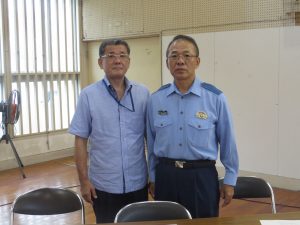 (Mr. Matsusaki and the principal, Mr. Tomiyama)
(Mr. Matsusaki and the principal, Mr. Tomiyama)
Mr. Matsusaki found out about the “2019 Okinawa karate instructors dispatching (promotion within the Prefecture) Project” (2), a project funded by the Prefectural Karate Promotion Division. In order to revive karate instruction within the police academy, he consulted the division’s head Yamakawa Tetsuo, and with the understanding and cooperation of Tomiyama Katsuo, academy prinicpal and Kendō 7th dan, karate instruction started again at the academy on June 5th.
Then, with Uechi-ryū Kenyūkai Higa Susumu as main instructor, short-term students (university graduates) and long-term students (others) were guided in a karate curriculum based on Uechi-ryū Sanchin, kote-kitae and kashi-kitae (forearm conditioning and leg and shin conditioning), Fukkyū-gata I & II, etc.
Seeing the students on the first day and the mood in the gym, an instructor recalls thinking “that won’t work!” However, all 47 short-term students (including 10 women) train hard and on August 29th, they were authorized to stand in front of a grading panel composed of 9 judges from the OKF among which President Taira Yoshitaka, Matsubayashi-ryū Hanshi 10th dan.
The contents of the examination were kihon-dōsa or basic moves, Fukkyū-gata I & II, Sanbon kumite, Sanchin, kote-kitae and kashi-kitae. Divided into 3 courts, everyone showed the results of daily practice. As a result, 39 out of 47 passed.
Compared to jūdō or kendō, karate is still not the officially part of the academy’s curriculum, so the judges received the following instruction from Mr. Matsusaki: “Do not hesitate to not pass students with an unsatisfactory level!". So doing, the value of the OKF 1st dan was preserved.
OKF’s vice-president and chairman of the Kenyūkai, Shinjō Kiyohide ended the grading with the following words. “Even for powerful people like you, there was too little training time. Even if some of you lack the technique and could not pass, I hope you will become kind-hearted police officers who understand pain.”
Nevertheless, the academy’s short-term students grew up into fine karateka in just 20 hours of training from June to August. The few unsuccessful ones vowed to do their best for the next test.
Long-term students will continue to study karate once or twice a week until December. Of course, jūdō or kendō and taiho-jutsu are also a requirement, and karate training is only an additional training.
During the evaluation gathering, OKF president Taira Yoshitaka who is a top disciple of Nagamine Shōshin, the founder of Matsubayashi-ryū commented: “Karate training was introduced to the Ryūkyū Police in 1918. Considering how to face a bad evil, karate comes as a support. For students who have not experienced a real fight, forearms and lower limbs conditioning and punches to the stomach is a way to understand pain. By not being upset, they will be able to make correct decisions. Training also leads to confidence. I am grateful for the introduction of karate in the prefectural police academy.”
“In June in Osaka, there was a case where a police officer was stabbed. I would like you to raise strong police officers through karate and its spirit of Sente nashi (3)” commented principal Tomiyama.
From now on, police academy students will continue to protect the safety and security of Okinawan citizens with their fists and hearts polished through the training of traditional Okinawan karate.
Notes 1
Master Nagamine Shōshin (1907-11997) was appointed police officer of the Okinawa Prefecture in December 1931, and his first assignment was at Kadena Police Station in central Okinawa. While working there for two years, he studied under Kyan Chotoku. Later, when he was dispatched to the Tōkyō Metropolitan Police Department as a research officer (April 1936), he studied under Motobu Choki for more than half a year. Nagamine retired from being a long-time police officer, and in January 1953 built a full-fledged karate dōjō named the “Matsubayashi-ryū Karatedō Kōdōkan” in Naha City. (Reference: Okinawa Karate Kobudō Encyclopedia, Nagamine Karate Dōjō website).
Master Miyagi Chōjun (1888-1953) began teaching martial arts at the Okinawa Prefectural Police Academy from 1922. In 1946, he became a karate instructor at the Okinawa Police Academy established in Gushikawa. (Reference: Okinawa Karate Kobudō Dictionary).
Master Miyazato Eiichi (1922-1999) studied under Miyagi Chōjun sensei in Matsuo, Naha City from 17 years old. During his time as a police officer, he assists master Miyagi and instructed at the police academy. (Reference: Okinawa Gōjū-ryū Karatedō Association website)
Komesu Kiyoshi (1942 ~circa 1980) studied under master Uechi Kanei, and according to a high-ranking senior of this system, “When people think of a police officer practicing Uechi-ryū, he was the hero of his time”. Retired in his late 20ies, he opened a dōjō in Tōkyō Hachioji. Later handing it to Mr. Shimoji Yasuo, he came back to Okinawa and open a new dōjō in Shuri Sakashita.
Note 2
Through the “2019 Okinawa karate instructors dispatching (promotion within the Prefecture) Project”, instructors will be dispatched for workshops in the Miyako and Yaeyama areas, and seminars, lectures and other related karate programs will be organized according to the needs of various organizations.
Note 3
Karate ni sente nashi, there is no first attack (or offensive intention) in karate.
[Okinawa Times] November 22, 1961
Kobudō 5
Soken, the successor of “Matsumura”
Soken Hōhan (70)
Kusarigama
He was born in 1891 in Gaja, Nishihara Village. Presently, he teaches students as an instructor of Shōrin-ryū (1) karate and kobujutsu.
Mr. Soken started karate when he was 12 years old. He was initiated by his mother Kamī’s elder brother, Mr. Matsumura (3rd generation of Shuri) (2).
He explains that although having reached a certain age, if a boy keep loafing, he won’t become a man which is why he was introduced to karate. But for the boy that Soken was still, it seems that training at that time was extremely strenuous. At 20 of age, leaving his parents’ home, he started living at the Matsumura Dōjō. He recalls that he would wake up before others students and undergo morning training, while training occurred also until late in the evening. At the beginning, training was light, but as his level improved, he event underwent training like the way to remove one’s geta clogs and escape. He explains that as the maxim “Karate ni sente nashi” tells, people who train in karate should also research “how to escape in any situation”.
In 1924, a martial art demonstration gathering martial artists from the entire island was held at the Taishō Theater in Naha. Mr. Soken performed next to Kyan Chōtoku, (Chanmī-gwā), Motobu Chōyū (Motobu Sārū) (3) and others.
Mr. Soken has 58 years of martial art experience. During these years, although he has crossed over to Miyako and Argentina, he has kept practicing diligently martial arts. Returning to his home town after WWII, he, as an orthodox (4) successor of Matsumura sensei took the name Shōrin-ryū and opened a dōjō in Gaja, Nishihara Village.
Since then, he has taught almost 200 students and still today, some 20 disciples train hard daily. During the coming demonstration, he will performed Kusarigama while 6 other students will also demonstrate on stage.
(Resides in Gaja, Nishihara Village)
Notes:
- Written Sukunai Hayashi
- Most likely the master known as Nabī Tanmē. According to the “Okinawa Karate Kobudo Encyclopedia”, a theory is that he was Tomimura Pēchin, one of the demonstrators during the last Ryukyuan reception for Sapposhi.
- While Motobu Sārū is the nickname of Motobu Chōki, in the original text it is written after Motobu Chōyū, the eldest son of the Motobu family.
- Seitō in Japanese can be translated in orthodox, legitimate and traditional.
- Master Soken passed away in 1982.
Shiroma demonstrating Ufutun Bō
Shiroma Taisei (77)
Ufutun Bō
He was born in 1885 in Ōzato Village Aza Ōshiro. At a young age, he became interested by watching the soul-stirringly Bōjutsu performances of the youth of the hamlet during festivals.
At the age of 17, he started practicing by visiting the house of Futenma Ōfu (1) sensei who was teaching Bōjutsu in the village. As he was gifted for athletics, his teacher told him “No mistake you will become skillful” and thus he was taken care of more than others. From then on, he kept practicing until 2-3 years after the end of the war. Remembering his young years, speaking with an impatient expression, he tells “No one can’t win over age, only now am I able to swing the staff…”
In 1928, he performed during the imperial commemorative demonstration for the present emperor that was held at Yonabaru Elementary School. His demonstration on that day is his most cherished memory.
“I would like for the youth of the hamlet to temper their body by learning Bōjustu, but the youngsters of today ignore the bō. Yet, this is a physical activity that one can have fun alone with at any time, and that is perfectly suitable within the countryside. If through the coming demonstration, some youth of the villages understand, even if young I will teach them. Now I am troubled as there is nobody. Even myself, only now am I confident on being capable of performing correctly at least the moves of Ufutun Bō.” So speaks humbly Shiroma.
He has been teaching his first son Seikō since a young age, and although he has learned Ufutun Bō, he presently lives in Sawatsu City in Shizuoka Prefecture. Because he was my son, he accepted my selfishness and whim; on moonlight nights, I more than once woke him up during the night and taught him on the hill.
He goes on saying “With the coming soon Kobudō demonstration, having notified him by letter that I was going to perform Ufutun Bō, my son was happy telling me to be careful but also encouraging me to do my best.” Then, grabbing the Bo that was placed in the Tokonoma alcove, he said “This is Ufutun Bō” and went on to perform the kata.
(Resides in Aza Oshiro, Ozato Village)
(1) The name’s reading is unclear.
[Okinawa Times] November 21, 1961
Kobudō 4
First ever demonstration of Dōchin
Kameshima Shinsuke (64)
Dōchin
He was born in Yonabaru Town in 1897. He served as the second mayor of Yonabaru and is presently the chairman of the town assembly. On the side of his busy assembly related activities, he opened the Shōbukan Dōjō and devote himself in instructing his juniors.
From the age of 15, he learned from Motobu Choyū sensei (elder son of Motobu sārū) among others. Since then and for more than 50 years, he has kept practicing karatedō. At the coming demonstration, he will perform the kata Dōchin.
Dōchin is a kata never seen in Okinawa therefore it will be the first ever demonstration in public. It is one of the many secrets that Mr. Kaneshima has in his repertory. He learned this kata from Chin Handō sensei (1) when traveling to Taiwan at the age of 17.
Kaneshima has dedicated his life to karatedō and he is eager to demonstrate, his face being filled with confidence. Very involved with the preservation of kobudō, he together with President Higa Seitoku, has gone all around the island to gather the authorities of kobudō. He is a driving force for kobudō’s revival.
He tells about his aspiration as follow. “I am deeply sadden as I see that native kobudō is slowly disappearing. It is partly due to the fact that authorities are passing away. With the coming public demonstration, we intend to film and thus preserve the kata demonstration of each masters. Through kobudō, we wish to nurture highly spirited and healthy youth that will be the leaders of tomorrow.”
Only the white vanishing hairs are a sign of the man’s old age. Indeed, his movements and his verbal attitude are filled with energy. From the days he started learning karate, he has never been sick once said this man who has developed a powerful physical appearance. And he will prove it as he will perform Dōchin for the first time in public. Wiping his sweat he goes on saying that he is not at all short of breath because as he explains karate built great physique and spirit.
(Yonabaru Town Morishita Ward 35)
Extra notes: According to the “Okinawa Karate Kobudō Encyclopedia”, Kaneshima sensei passed away in 1990 at the age of 93. He studied in his younger years in Taiwan under Tokuyama Chōgi who himself studied under Shurite expert Onaga Ekata. In his 30ies, he studied with Chin Handō. Later, Kaneshima named his system Tozan-ryū which is written with the 1st and 3rd characters for Tokuyama.
Today, some of his students continue his legacy using the name “Shōrinpa Kenpō Tozan-ryū.”
Learning the staff from his grandfather
Chinen Masami (63)
Sakugawa no kon
He received direct transmission of Sakugawa no kon (Bōjutsu) from his grandfather Saburō (1).
It is said that “Sakugawa no kon” came from China, and there are few experts in Okinawa. Mr. Chinen began his career at the age of seventeen. When he was a child, he used to study karate with his younger brother Seishō (2), but tormented by the practice, he switched to Bō. He says that the reason is that while he took a break in his karate training, his younger brother Seishō improved. He says that he had given up martial arts for a while as he was vexed from losing to his brother, but on the recommendation of his grandfather he started Bōjustu. Chinen's grandfather Saburō was known as a Bō expert, his technique being called the “form of Yamannī”.
Sakugawa no kon is one of the special skills of Grandpa Saburō. It's somewhat different from other cudgels’ techniques; you pretend to strike but actually thrust. When thrusting, you do so while twisting the cudgel. Mr. Chinen received instruction from his grandfather, and as a legitimate inheritor Sakugawa no kon, he will perform this kata at the demonstration, but he adds “Bōjustu is a martial art my grandfather devoted his life to. I want to do my best during the demonstration with the meaning of preserving the kata of my grandad”. Sakugawa no kon is still preserved in the Kakazu district of Madanbashi (3), but now there are only a few experts as it is a forgotten martial art. It is only inherited by a few elders.
With the coming demonstration, Mr. Chinen said that “he would like to become a good adviser for President Higa and also wants to do his best for Kobujutsu”.
(1) Most likely Chinen Masanra, known as the founder of Yamannī-ryū.
(2) The name’s reading is unclear.
(3) The Kakazu district is presently in Tomigusuku. Not far from there can be found the Ryūkyū Kobudō Shimbukan founded by Akamine Eisuke sensei. Akamine sensei was born in Kakazu and studied the Bō of Kakazu that was taught directly by Chinen Masanra. He is followed by his son Akamine Hiroshi, present head of the Shimbukan.
A video of the demonstration released by the Okinawa Traditional Kobudo Preservation Society Bunbukan:
https://www.youtube.com/watch?v=6YSyJjtBwMk&feature=share&fbclid=IwAR3z6GeXqOLPaHW0dENUElSG96gIFABih-YXSUY0YsJQWTCbcVTiyvBD4T8
[ Okinawa Times ] November 17, 1961
Kobudō 3
Studying with Chanmī-gwa and others
Nakamura Shigeru (67)
Niseshi
He was born in 1894 in Nago Town (1). When he was 15 years old, he entered the Okinawa Prefecture Junior High School (2), joined the school’s karate club and started to learn karate. From a young age, Mr. Nakamura was extremely interested in karate, listening to many tales and stories from elders and seniors. For this reason, and because he redoubled of enthusiasm, he quickly progressed in karate. During the coming demonstration, he will perform “Niseshi” kata that he learned from the nicknamed “Kuniyoshi no Tanmē” (3). The kata itself doesn’t have many various techniques, however there are very few experts of it in Okinawa making this kata a precious work of art.
In the past, Mr. Nakamura zealously studied karate together with Chanmī-gwa and Motobu-sārū (4) which makes him a karateman from the roots. Next to karate, he also knows Bō (staff) and Sai (trident) amongst others.
However, in the 50 some years of his martial art life, he had to face many hardships. He explains that he had to go to training sessions in cold winter nights and travel on many journeys in order to study karate. Such types of hardships built Mr. Nakamura’s temperament and helped him nurture an indomitable force of will that never bends in front of something. Today, he has a dōjō in his house and it is said that the number of his students goes up to 1,000.
Nowadays in Okinawa karate, there are many various styles, however, Mr. Nakamura said that “In the past, there were no styles in karate. To develop Okinawa karate, all styles must be united (5).”
In the dōjō of Mr. Nakamura hangs a framed picture on which is written in large letters “Jinkaku Kansei” (6). There, obeying the teaching of their master, students zealously train days and nights.
(Lives in 489 Nago Town)
(1) Today Nago City.
(2) Today’s Shuri Senior High School was once the “1st Okinawa Prefectural Junior High School” while today’s Naha Senior High School was the “2nd Okinawa Prefectural Junior High School”.
(3) Alias for Kuniyoshi Shinkichi (1848-1926), “Tanmei” being a word that could be translated into grandpa or old man. According to the “Okinawa Karate Kobudo Encyclopedia”, Kuniyoshi was born in Kumoji Village (present Naha) and learned Nahate from Sakiyama Chikudun nu Peichin (who himself studied in China with Ru Ru Ko). Kuniyoshi’s mastery was considered equal to Higashionna Kanryō’s mastery. When 60 years old, Kuniyoshi Shinkichi moved to Nago.
(4) Nicknames for respectively Kyan Chōtoku (1870-1945) and Motobu Chōki (1870-1944).
(5) The word “united” could also be translated in “standardized”.
(6) “Character completion” as in personality brought to perfection.
Extra note: According to the “Okinawa Karate Kobudo Encyclopedia”, Nakamura studied under Itosu Anko when in junior high school and passed away in 1969.
Father and son demonstrating Tenbē together
Higa Yūsuke (70)
Tenbē
As kobudō is slowly being forgotten, the only person who performs “Tenbē”(1) today is Mr. Higa. Devoting himself to the preservation of Tenbē, the role of Mr. Higa is very important. Showing a strong volition, Mr. Higa explains: “With the fear that the art of Tenbē might cease to exist, I had some helpless feelings but today, as I am speaking with kobudō concerned people in order to restore this martial art, I am quite happy. With people capable of performing Tenbē all passing away, we cannot spare our efforts. Myself, although I am getting old, I wish to perform Tenbē in my own way.”
Tenbē is a fight between someone armed with a woven hat (2) and a sword and someone armed with a spear. During the demonstration, Mr. Higa will perform with a hat and a sword while his 5th son named Yūfuku will perform with a spear. As a familial combination with good spirit, they will do their best for the resurrection of Tenbē. In the case of the sword and hat handler, he must jump freely over the opponent. It is said that it is because it is hard to jump high over someone that this martial art is not really popular.
Imitating the jump and speaking in Okinawan, Mr. Higa says, “When I was young, it was nothing for me to jump over you.” A small but solid and muscle tightened man, it is easy to imagine that when he was young, this energetic old man could jump freely over somebody.
Born in 1891 in Kudeken, Chinen Village, he joined the Oita Infantry 72 regiment in 1911. He was discharged in 1913. He explains than after being discharged, when he was 24 years old, he received instruction from Arakaki sensei from Shuri. The hard training he received when in the infantry helped him in the study of Tenbē, an art that he quickly mastered. After the death of Arakaki sensei, he taught the art to the youth of Chinen, Takagusuku and Sashiki but the incessant hard training was too much to cope with and many quit training, letting him with his son Yūfuku as only partner.
Keeping himself busy working on a farm on one side, Mr. Higa trains hard in view of the demonstration.
(1) Also called Tinbē.
(2) Written kasa in Japanese, it could also mean umbrella.
